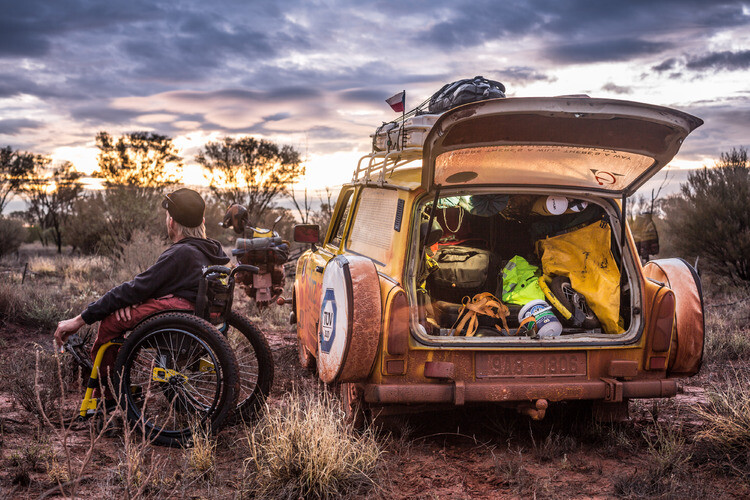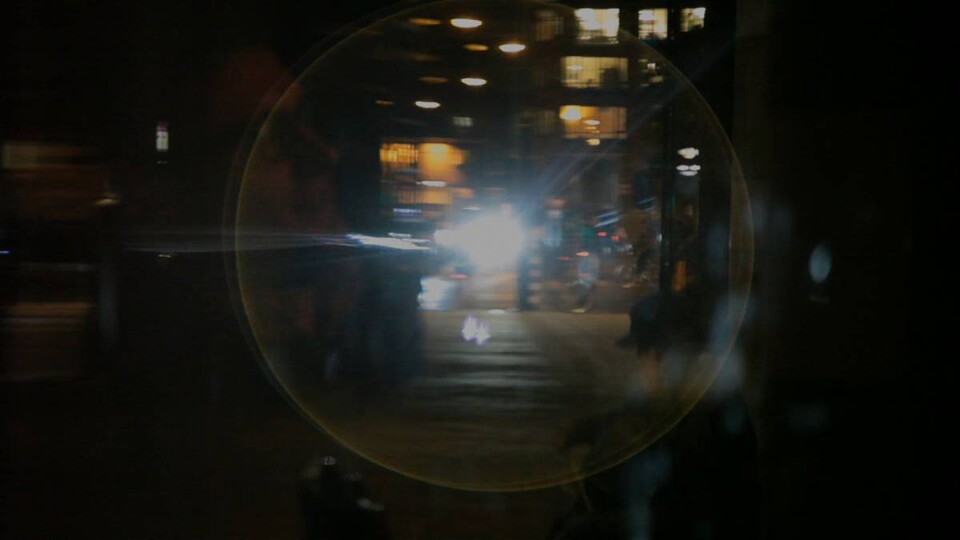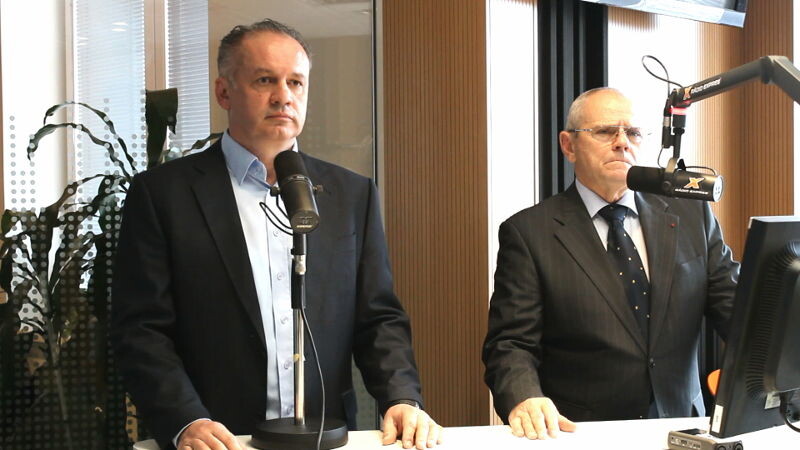Wasted Potential of the Good Old Trabi
Crammed in Trabant cars, they set out to travel one more continent – this time crossing Australia and a part of South-East Asia. According to reviews, the latest of the series of films by Dan Přibáň called With Trabants to the Last Breath is also the most accomplished and sophisticated – and yet their authors explicitly disregard issues which would have been seen as flaws in other films. A trio of reviewers – Tomáš Stejskal (TOS), a film critic contributing to Hospodářské noviny daily, social scientist Tereza Stöckelová (TES) and founder of Brno Expedition Club Albert Fikáček (AF), who has recently attempted to cross from France to Algiers on a boat made of PET bottles – discussed the message and the aspirations of the “Trabi” film from the perspective of a creative, or artistic, documentary film.
AF: In terms of box office figures, the film has been pretty successful. But I have to admit that especially the first part did not bring anything new, no new facts about Australia, there was no action – which was replaced by everyday activities such as tooth brushing or going to the toilet, which could spice the film up, but not serve as the film’s main theme. When the expedition reached East Timor, I started to enjoy the film – which eventually became interesting as the cars started breaking down.
TOS: In the context of Přibáň’s previous films, an improvement in the recording technology as well as its operation is evident – with the entire project shifting from authentic travelogue towards a movie intended for the big screen. The question is whether it is legitimate to ask the authors of the film to produce a creative, artistic or, in general, genuine documentary work. In the best sense of the word, it represents an amateur work that naturally has its limits. Unlike previous films about the “yellow circus”, the director’s attention turns to the expedition members and their relations. Travelling rather serves as a means to get to know the people. However, the potential arising from the decision of a group of people to pack up and get into old Trabis to travel the continent is entirely wasted. Interesting situations are only slightly touched upon and remain unleveraged. I wonder what else could be done with the recorded footage – most probably an entirely different film could be edited.
TES: What is remarkable is the film’s great popularity – from the sociological perspective, I see it as the manifestation of the age of YouTube. Just like a series of YouTube videos, the resulting film is poor. It’s not about Trabis, or the expedition members, it’s not even about the countries they visit, or their inhabitants. In this respect, there was for instance one situation when the locals organised a ritual ceremony for the broken cars and motorbikes. Despite a great potential of such a situation – we could see nothing but a few exotic images. It remains unclear why and for what consideration the locals organised the ritual or what is their relationship to modern technologies. What we are left with is merely a vague romantic representation of some kind and incomprehensible Other.
AF: The reason why the film is so popular in the cinema can be seen in the fact that it’s presenting something unconceivable for common people. And such a film can inspire people and motivate them to act. When I’m planning an expedition, I invite up to 40 potential fellow travellers, most of which say they’d love to go, but they never leave, because their mum has just baked a cake, or because they have to do their school exams, or because they’re afraid to hitchhike. I hear all sorts of funny excuses. Then you have someone like Dan Přibáň who crosses half of the globe in his Trabi and asks nothing. Besides, the fact that he had a wheelchair user in his team can show people that they shouldn’t think twice. Some might realise that the reason is not that it’s impossible, but that they don’t want to do anything. That’s why – as bad as the film could be – I still believe that these couple of minutes or hours are definitely worthwhile.

With Trabants to the Last Breath (Trabantem do posledního dechu, Dan Přibáň, 2016), source: Aerofilms
Dating reality show at the antipodes
TOS: The film is intended for fans and people who chipped in to one of the most successful crowdfunding campaigns in our country. I would have expected a film like this to provide a different kind of experience than conventional travel TV shows. Even the voice-over is an artificial component indicating a reality show and other genuine TV formats. This leads to de-humanising. You have a format narrated by a hired actor who has no personal experience related to the topic. As if someone sat down and wrote a nice fairy-tale. There surely is a potential to create a powerful story merely through the moving image.
AF: Had the whole story been narrated by one of the expedition members, the voice-over could have been entirely different and could actually contribute to the overall quality of the film. Another question is how much and what kind of material was shot in Australia. Given the type of the trip, it must have been pretty monotonous. More countryside scenes, or a kangaroo, might have made the audience happier. It would not have saved the film as a whole, but I guess that such scenes should be an integral part of every travel movie.
TOS: In fact, such a monotonous trip could produce very interesting situations, various interpersonal conflicts which could lead to a more general statement through the filmic imagery. Why should its value lie in scenes showing exotic animals? Kangaroos and other animals can be seen anywhere else. On the other hand, viewers want to find out what happens on an expedition like this when, for instance, I bring my girlfriend along for a couple of months to join the men-only team. Like this, it is another of those films that only show nice images.
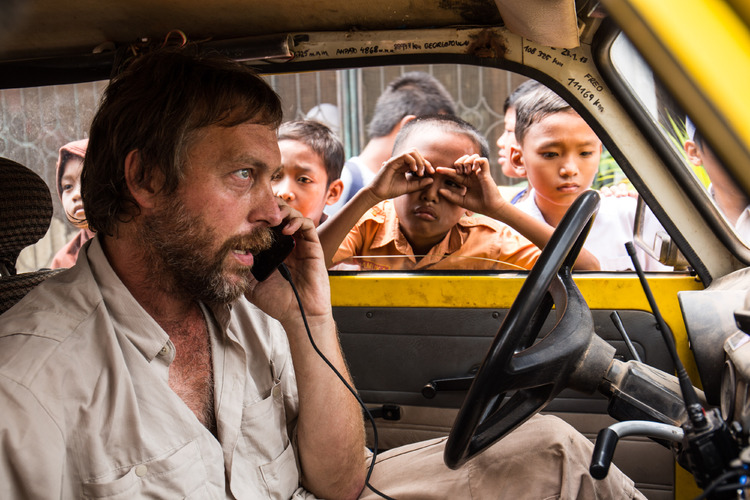
With Trabants to the Last Breath (Trabantem do posledního dechu, Dan Přibáň, 2016), source: Aerofilms
AF: I see it as an impossible task for the main protagonist, director and editor in one to capture such complex personalities and relations that we could see in Přibáň’s team. He would have had to give up on his privacy and perhaps the resulting format would resemble a reality show.
TES: But this is a noteworthy point. What’s the use of a pointless finding that a small team starts to suffer from cabin fever after six weeks? In the case of a creative documentary, the protagonist, or the author, has to be exposed.
TOS: Only few of us are capable of such a level of self-reflection to produce a great film, especially if this is not their main aim. When a filmmaker is shooting a diary film, he or she always intends to expose him- or herself. And it may take as much courage as to take an old junk car to cross several continents so why should the same person not be able to find enough courage to open his or her privacy?
Travelling as a genre of its own kind
TES: I found the entire project interesting mainly as a phenomenon of the modern times, when young people feel the need to do something – literally or metaphorically – for their facebook friends. Why do people massively participate in such a project, what type of needs or emotions do they project therein, are they really motivated to act, as Albert has put it, or do they experience a part of a journey across Australia by watching the film while staying in their old tracks? It is also noteworthy that in such a configuration, the reality of the journey does not simply precede the film, that it is co-created in real time. The question is whether the travellers would have reached their goal had they not been filmed.
AF: I was very surprised when they were considering packing up and going home. This must have been a great challenge for Dan Přibáň when he had to follow the wishes of the team. One thing is to consider the film itself, and the other is to look at the Trabi project. Even though we can have doubts about the film’s quality, the project is praiseworthy, just in that it has a positive impact. This suddenly opened the doors of Czech Television for travellers and adventurers, people started going to the cinema in large numbers and they might tend more towards the opening of borders in the form of travelling.
TES: I would be more cautious. For me, the film borders on fetishizing of travelling, this time in an adventurous genre.
TOS: We can talk about curiosities, fetishizing or any other symptoms of the modern society that is looking for more and more extremes to entertain itself to death. I think that it’s a bit unfair to put this film on par with a random video posted on YouTube. On the other hand, we have to ask again, if this film can’t be anything else than a much more authentic curiosity, just like any YT videos, or whether we should be able to discern its potential to become more than a TV travel show. It seems more beneficial to me to watch a trip in a Trabi across Australia than to watch weird and colonial raids, unfortunately still produced by Czech Television. In this context, this film can be seen as very good, albeit being a sort of a “DIY” project.
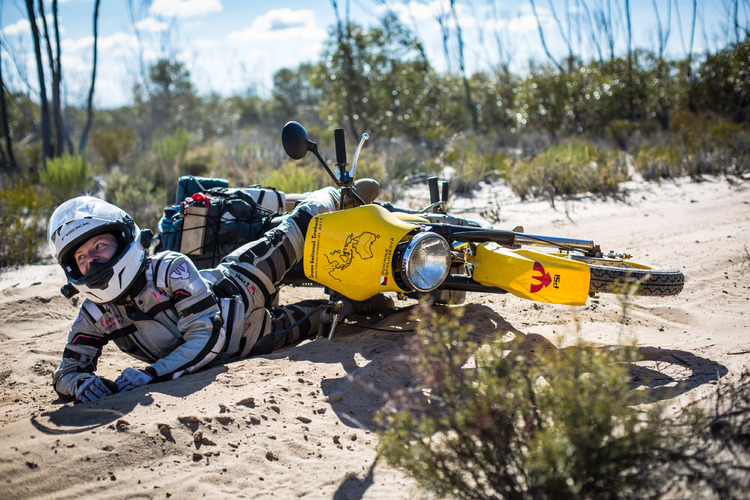
With Trabants to the Last Breath (Trabantem do posledního dechu, Dan Přibáň, 2016), source: Aerofilms
TES: OK, it is not the same as if I make a video of myself having a hamburger for a dinner and post it on YouTube to entertain the world. There still is this undisputable moment of exposing oneself. By exposing yourself to a risk you are not creating a value in itself, the question is: what’s the point? At times, the film felt as an exhibition in pointlessly putting oneself (and consequently the entire group) to danger. When, for instance, Doctors without Borders work in Yemen, only an hour away from the firing line, we know that they have to push their limits and risk their lives to save the lives of others. It is not the same as riding across Australia on a motorbike. I don’t want to be in the position of someone who decides what’s sufficient as a higher goal, but the film’s authors fail to offer anything else than an empty phrase: “clench your teeth and go, you’re bound to reach Nirvana”.
AF: One of the biggest problems in our society stems from the comfort we are living in, which causes our abilities to fast degenerate. We are even too lazy to work! We lost our sense of smell and fast reflexes a long ago, but now we’re losing genuinely human qualities and the only way how to stay physically and mentally fit is to expose ourselves to some adversities. That doesn’t come automatically – we haven’t experienced war for over 70 years, and minimum of disasters, and so we have to search for the adversities, going skiing on a black slope, trying to cross the sea on plastic bottles or to travel across Africa, America and Australian in a Trabi. The meaning doesn’t have to be clearly expressed, but it is concealed within this mechanism.
TOS: What does this type of experience lead to? The search for hardship can be a great added value, but this film fails to show it. It doesn’t seem to me that such a meaning could be transferable to me as a viewer for example through empathising or other mechanisms that are involved in my viewing experience. The film doesn’t show anything else than that by falling off a bike, you can get impressive scars which, however, might not affect the frame of mind of the team of travellers.

